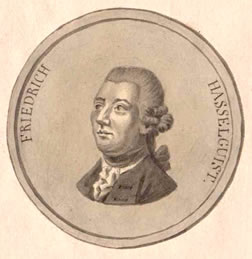ikfoundation.org
The IK Foundation
Promoting Natural & Cultural History
Since 1988



iFACTS | Fredrik Hasselquist
| Date of Birth | 3 January 1722. |
|
Place of Birth |
Törnevalla, Östergötland, Sweden. |
| Date of Death |
9 February 1752. |
|
Place of Death |
The vicinity of Smyrna, Turkey. |
|
Monuments Medals Etc. |
|
| Variations of Name's Spelling |
|
| Preserved signature | In correspondence. |
| Portrait |

Portrait engraving with the name ‘Friedrich Hasselquist’ added, undated. [source; Österreichische Nationalbibliothek, Digital Portrait Collection Port-00083367-01] |
| Childhood, Adolescence & Education |
|
| Professional Life |
|
|
Journeys & Voyages |
|
|
Travel Diaries & Other Publications in Connection with the Journeys & Voyages |
|
| Civil Status & Family |
Unmarried. |
|
Preserved Collections & Manuscripts |
|
| Extra Notes |
|
| Added Knowledge | Discover... |
iFACTS
In iFACTS biographical facts of each individual Linnaeus Apostle are described, a total of seventeen men who made long voyages from the years 1746 to 1799, more than 50 years of travel in the service of science!
Biographical details of each individual apostle are presented in various subjects together with maps that display an overview of their personal backgrounds and travels. The geographical span of the apostles' voyages can most easily be followed in iFACTS and iMAPS.
Additionally, iFACTS give the user statistical information about the number of search terms for each apostle in iINDEX, together with relevant links to iLOG, ADDED KNOWLEDGE and iPROJECTS.
iFACTS are continuously updated with new information.
THE LINNAEUS APOSTLES
PATRONAGE
This site/project has been made globally available in collaboration with:
 The Thora Ohlsson Foundation, Lund, Sweden
The Thora Ohlsson Foundation, Lund, Sweden
Feel welcome to read more about how to take part...
 The Thora Ohlsson Foundation, Lund, Sweden
The Thora Ohlsson Foundation, Lund, Sweden
Feel welcome to read more about how to take part...
Updated/Checked 29/05/2018
THE IK FOUNDATION & COMPANY PROMOTING NATURAL & CULTURAL HISTORY
SUBSCRIBE TO OUR NEWSLETTER
TRANSLATE PAGE
A link to this page has
been copied to your clipboard
SHARE @been copied to your clipboard




© The IK Foundation & Company 2026
– a truly European organisation since 1988
– a truly European organisation since 1988
Legal issues | Forget me | and much more...
How to cite & Creative Commons
You are welcome to use the information and knowledge from
The IK Workshop Society, as long as you follow a few simple rules.
LEARN MORE & I AGREE
You are welcome to use the information and knowledge from
The IK Workshop Society, as long as you follow a few simple rules.
LEARN MORE & I AGREE







